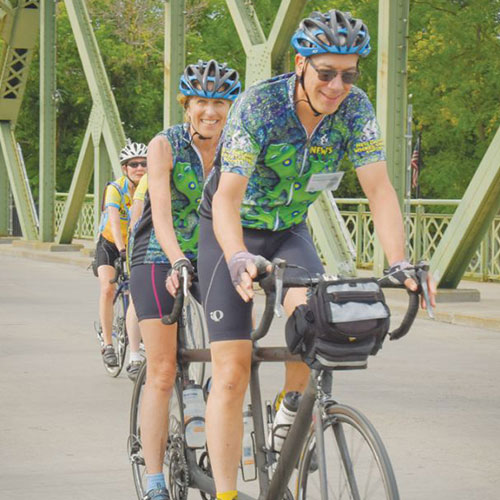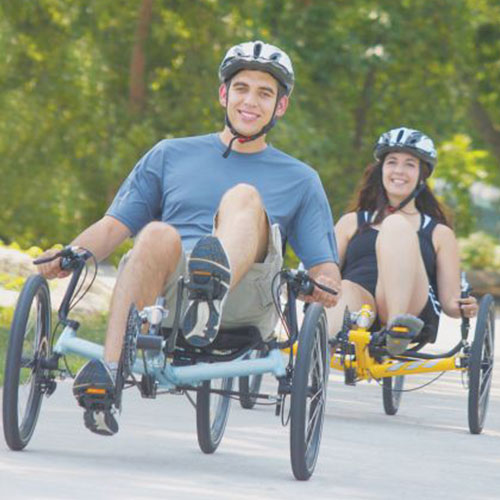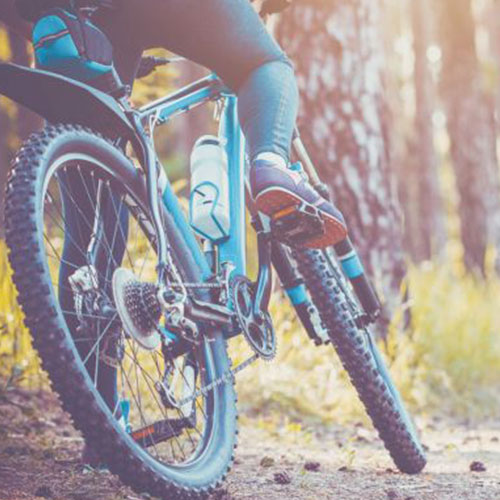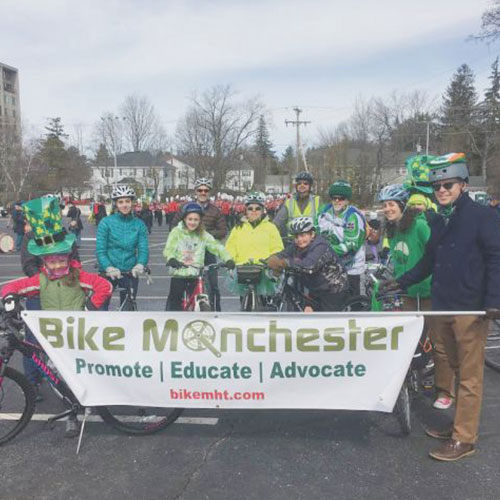FEATURED POP - * COVER STORY *
Built For Two
Built For Two
Ride with a Partner on a Tandem Bicycle
Written By Angie Sykeny (asykeny@hippopress.com)
Images: Courtesy Photo
There’s an old adage about riding a tandem bicycle.
“The saying is, ‘Whatever direction your relationship is going, you will get there faster on a tandem bike,’” said Susan Hollinger, a New Hampshire tandem cyclist and president of the Eastern Tandem Rally, a group of tandem enthusiasts hosting rides and events in the Northeast.
A tandem is a bicycle designed for two people to ride at once. It has two seats — a regular seat and a seat directly behind it — and two sets of pedals, linked so they turn together and at same rate.
“You’re not independent at all,” Hollinger said. “It requires the two people to work together in sync and to communicate to move the bike and cover the distance. And it’s incredibly fun.”
Partnering Up
Riding tandem is a great option for two people who want to get outside and be active together but who have different physical skills or endurance levels.
“The bike is an equalizer,” Hollinger said. “One [rider] may be a competitive cyclist and the other may like to go slower, but the bike does all the equalization, so they get [to their destination] at the same time, and no one feels like they’re bugging the other person or waiting for them to catch up.”

Tandem cycling also gives riders an opportunity to socialize and spend more quality time together, as opposed to riding individual bicycles side by side, where the riders may fall in and out of earshot and are focused on keeping the same pace with each other.
From a fitness standpoint, Hollinger said, many people tend to ride harder and for longer distances when riding tandem.
“I think it’s because you’re just having fun the whole time,” she said. “It never really feels like work.”
Staying in Sync
On a tandem bike, the person riding in the front seat, also known as the captain, handles the primary maneuvering actions like steering and shifting gears. The captain is typically the more experienced cyclist. The person riding in the back seat, also known as the stoker, acts as “the engine,” Hollinger said, simply providing additional pedaling power.
Tandem cycling requires a significant amount of communication between the two riders. Verbal communication may include the captain informing the stoker about a change in terrain that lies ahead or when he is about to switch gears, or the stoker telling the captain when they want to glide or do standing pedaling. There is also a lot of nonverbal communication that comes with practice, like learning how to lean in unison with your partner and match his weight distribution when making turns.
“Starting out, you have to talk to each other a lot and tell each other what’s going on,” Hollinger said. “But over time, you don’t have to say as many things aloud. You communicate intuitively and through body language.”
Types of Tandems
Tandem bicycles are available in many of the same styles as single-rider bikes; there are ones for casual cruising and street riding, fitness and racing, and even mountain biking and hill climbing.
“The Mount Washington Hill Climb often has several tandems that do it,” Hollinger said. “There are tandem bikes built to do that. They have a lot of gears so people can take them up steep hills. They’re very sturdy and well-designed, and they hold up well.”
When it comes to cost, tandem bicycles span a wide range but are typically more expensive than single-rider bikes. A good-quality tandem bicycle may cost between $1,000 and $10,000, Hollinger said. If you want to try before you buy, there are some bicycle shops and outdoor recreation venues that offer tandem bicycles to rent. Many beach resorts also offer simple cruiser tandems to rent and ride.
“Those are what you think of as the classic ‘bicycle built for two,’” Hollinger said. “It’s a different thing altogether from the world of tandem fitness biking, but they’re usually very manageable, and it can be a lot of fun to just take one out for the afternoon and tour around the beach.”
Hitting the Road
If you’re just starting out with tandem cycling, it helps to be comfortable and confident riding a regular bicycle first. Riding a tandem is about as physically demanding as riding a regular bicycle on level terrain. At an incline, however, it can be more challenging because having two riders creates more weight to push up the hill.
“It’s like an 18-wheeler truck; it moves slowly uphill,” Hollinger said. “But the downhill makes up for it. You fly downhill very fast on a tandem.”
It’s best to learn on a flat, paved surface with little traffic, such as a large parking lot or a quiet back road. Then, when you go for your first real ride, start with a manageable distance like 10 or 15 miles.
Ideally, you should spend your first few rides as the stoker, with a captain who is experienced with riding a tandem.
“If you’re going to be riding on the back, it lets you feel what it’s like to not steer or shift,” Hollinger said, “and if you want to ride on the front, you can get a feel for what the captain is doing so you can tell if it’s going to be comfortable for you.”
Find a Tandem Bike
Here are some local bike shops that carry new or may carry used tandem bikes, or can order one for you.
The Bike Barn (33 S. Commercial St., Manchester, 668-6555, bikebarnusa.com)
Colonial Bicycle Co. (419 South Broadway, Salem, 894-0611; 775 Lafayette Road, Suite 5, Portsmouth, 319-1688, colonialbicycle.com)
Cycles Etc. (288 N. Broadway, Salem, 890-3212; 450 Second St., Manchester, 669-7993, cyclesetcnh.com)
Durham Bike & Sports (72 Main St., Durham, 397-5140, facebook.com/durhambike)
Exeter Cycles (4 Portsmouth Ave., Exeter, 778-2331, exetercycles.com)
Goodale’s Bike Shop (14B Broad St., Nashua, 882-2111; 1197 Hooksett Road, Hooksett, 644-2111; 19 Triangle Park Drive, Concord, 225-5111, goodalesbikeshop.com)
Gus’ Bike Shop (55 Lafayette Road, North Hampton, 964-5445, gusbike.com)
Jake’s Bike Shop (580 Mast Road, Manchester, 666-4527. jakesbikesnh.com)
Likin Bikin Bicycle Shop (Salzburg Square, 292 Route 101, Amherst, 249-5737; 5 Monument Square, Alton, 875-7141, likinbikin.com)
Maverick’s Square Adaptive Cyclery (141 Route 101A, Amherst, 554-8260, maverickssquare.com)
Ocean Cycles (76 Lafayette Road, Hampton Falls, 926-5757, oceancycles.net)
Papa Wheelies Bicycle Shop (635 Islington St., Portsmouth, 427-2060, papa-wheelies.com)
Philbrick’s Ski, Board & Bike (161 Portland Ave., Dover, 742-9333, philbricks.com)
Lean Back & Go
Lean Back & Go
The Benefits of Recumbent Biking
Written By Ryan Lessard (news@hippopress.com)
Images: Courtesy Photo
Recumbent bikes are the strange mutants of the cycling world, beloved by many, reviled by others. But fans say the lean-back-with-the-legs-in-the-front approach is a more efficient use of energy and strength and offers a riding option for people with physical or cognitive disabilities.
Maverick’s Square Adaptive Cyclery is one of the few places in New Hampshire that specializes in recumbent bikes and carries an inventory in its store, according to co-owner Nathan Moreau. The shop also performs modifications for special needs, like putting all the brakes and shifters on one side for stroke victims.
“We don’t do anything normal, I guess, on the bike side,” Moreau said.
The company started six years ago and Moreau said recumbents are its “bread and butter.” It partners with rehab centers like Crotched Mountain in Greenfield and Northeast Passage in Durham.

“It gives freedom back,” Moreau said.
Folks with inner-ear problems or brain injuries may have trouble balancing, so the three-wheel option is best for them.
Recumbent bikes come in a number of variations. There are tricycles, bicycles and some that are slightly more upright with high handlebars but still with a backrest for a more relaxed seat.
“You’ve got handlebars on both sides — you sit between them and they’re physically connected to the pivot point on the wheel,” Moreau said.
For some, it can be as easy as riding a traditional bike, but for others, it can be difficult to get the hang of it.
“Either you get it really quickly or you hate your life,” Moreau said.
Still, he encourages people to try out all the variations of recumbents available. Someone who doesn’t do well with a two-wheeler may do well with a three-wheeler. That’s because recumbent bicycles require more balance and leaning like a traditional bike, whereas trikes do not.
“It’s a different type of balance. It’s like being in your recliner and trying to ride a bike,” Moreau said.
Two-wheelers can also be difficult to get started. Moreau said a rider needs to sort of “Flintstone” run to pick up momentum and then pick their feet up.
Moreau finds the three-wheeler to be his favorite form of conveyance these days. He can go for 20 miles on a recumbent trike with the same energy that would take him half the distance on a traditional bike.
Plus, with the stability afforded by three wheels, he can spend less energy trying to stay upright.
“My body doesn’t wear out as quickly because … I’m not using the same type of muscle groups. I’m using a more diverse muscle group,” Moreau said. “You’re not using your legs to fight balance.”
He said it also works out the core more than a traditional bike. Because of the way your body needs to shift side to side, he said, your lower abdomen gets a good workout.
“They’re a blast to ride, they’re super-comfortable and it’s a lot of fun,” Moreau said.
Co-owner Dan Horn says he thinks most local triathlons and duathlons will accept recumbent bikes but racers should always check with a race organizer first to be sure. Some more official racing circuits might be less inclined to allow recumbents, he said.
One bike race called the Three Notch Century in North Conway includes a lot of recumbents, according to Horn. The event, which takes place this year on Saturday, Sept. 9, helps raise support for Northeast Passage.
Many websites sell recumbents online and some local shops can special-order them for you.
Moreau said the only downsides to recumbent bikes are that they’re low, so you need to add flags and lights to your ride so motorists are more likely to notice you, and they’re often too bulky to easily store or transport. He said some companies do make specialty variants that can fold into smaller sizes, making them easier to travel with or pack away for the winter.
Want to try before you buy?
If you’re curious about this biking option and want to try one out, Maverick’s hosts a weekly group ride every Sunday night at 6:30 from Nashua to Pepperell, Massachusetts, along the Nashua River Rail Trail, which is a 10-mile round trip. Folks can come and use a floor inventory bike for free, if available, and ride with the group to an ice cream shop and ride back. The whole trip takes about two hours.
Find a recumbent bike
Here are some local bike shops that carry new or may carry used recumbent bikes, or can order one for you.
Colonial Bicycle Co. ( 419 South Broadway, Salem, 894-0611; 775 Lafayette Road, Suite 5, Portsmouth, 319-1688, colonialbicycle.com)
Cycles Etc. (288 N. Broadway, Salem, 890-3212; 450 Second St., Manchester, 669-7993, cyclesetcnh.com) (can order)
Goodale’s Bike Shop (14B Broad St., Nashua, 882-2111; 1197 Hooksett Road, Hooksett, 644-2111; 19 Triangle Park Drive, Concord, 225-5111, goodalesbikeshop.com)
Maverick’s Square Adaptive Cyclery (141 Route 101A, Amherst, 554-8260, maverickssquare.com)
Ocean Cycles (76 Lafayette Road, Hampton Falls, 926-5757, oceancycles.net)
Choose Your Weapon
Choose Your Weapon
Mountain and Road Biking in New Hampshire
Written By Kelly Sennott (ksennott@hippopress.com)
Images: Stock Photo
Unless you’re going tandem or recumbent, there are two main options for bike riding: mountain biking and road biking.
“There’s a bicycle that can satisfy any need you have for riding, whether it’s on the road at high speed preparing for a triathlon or a casual spin around Lake Massabesic, to soak up the terrain or have a picnic lunch. You can do it all,” said Dan Dwyer, a local bike enthusiast and vice present of the Southern New Hampshire chapter of the New England Mountain Bike Association.
The Bike
Road bikes allow you to go fast, with thinner, larger tires for efficiency’s sake, and a saddle (seat) height that positions you almost parallel to the road in an aerodynamic position. Mountain bike tires are more rugged, allowing bikers to master rocky terrain, with seat heights that put riders upright, balanced and ready to meet obstacles. Saddles are normally more narrow on road bikes and performance bikes.
Other major differences have to do with handlebars — mountain bikes’ are usually wide and flat, road bikes’ dropped — plus gears and brakes. Mountain bike gears are lower, and brakes are higher-end, borrowing suspension and braking technology from motorcycles.

“When you’re off-road, descending steep trails, you really need good braking power,” Dwyer said. (Though these brake styles are also making their way into high-end road bikes too.)
If you’re not willing to sacrifice comfort or speed, or off-road options, shoot for a hybrid, or a bike that takes from the best of both worlds. Dwyer mentioned a new style called the gravel-grinder, which is like a beefier road bike designed for comfort and to facilitate off-road adventures.
“You have quite a wide variety of hybrid bikes, crosses between mountain and road bikes, that have upright handlebars similar to mountain bikes, and that are lighter weight and go higher speeds,” said Dave Topham, co-founder and on the board of directors of both the Bike-Walk Alliance of NH and Granite State Wheelmen.
Both Dwyer and Topham said that staff at a local bike shop can help you find the best style for you, and determine how to size your bike to fit just right.
With both road and mountain biking, your legs should be nearly fully extended at the bottom of the stroke — which means that you probably won’t be able to put both feet on the ground when at a standstill. Another way to measure is to look at the height of the top tube (the top metal bar connecting handlebars and seat). When you’re straddling the frame of the bike with both feet flat on the ground, there should be a couple inches of clearance.
Road Biking Rides
If you haven’t biked all winter, Topham said to start slow. Begin with shorter loops and work your way up. He recommended checking out the New Hampshire Department of Transportation’s seven regional bicycling maps (nh.gov/dot/programs/bikeped), which contain road and route suggestions, plus information about local rail trails, paved and unpaved. Updates on the ongoing construction at the Granite State Rail Trail, a route spanning from Salem to Manchester to Lebanon, are posted at facebook.com/GraniteStateRailTrail, where you’ll also find parking information. The longest paved segment of this trail is from Salem to Windham to Derry at 8.6 miles.
Mountain Bike Rides
As a Manchester resident and member of the Friends of the Massabesic Biking Association, Dwyer loves exploring the trails surrounding Lake Massabesic, most of which start near the parking lot in Auburn off the traffic circle.
Around Nashua there’s Mine Falls Park, which offers beginner-friendly flat trails, and Yudicky Park, which is a little more advanced. In Merrimack you can mountain bike through Horse Hill Nature Preserve, Grater Woods or the Wildcat Falls Conservation Area.
Farther north, Dwyer said he enjoys the trails behind Concord Hospital, which include the Winant Park, Marjory Swope and the West End Farm trails. Farther east is one of the “most highly regarded” venues for mountain biking, Bear Brook State Park in Allenstown, and even farther north is Highland Mountain Bike Park in Northfield, the world’s only lift access mountain entirely dedicated to biking, according to to its Facebook page.
Safety
No matter what style of biking you’re embarking on, it’s important to do what Topham calls the “ABC Quick Check.” Is there air in your tires? Are your brakes working? Are chains and gears working properly? Make sure nothing’s rattling today that wasn’t yesterday. He advised installing blinking LED lights for both day and night — which he said has proven to result in 30 percent fewer crashes between cars and motorists — and a warning bell to let pedestrians know you want to pass.
Especially if you’re going on a longer ride, you should take a pack with you containing water, a spare tube, pump and simple hand tools for on-road maintenance in case something happens to your bike en route. Keep clothing out of moving parts, like shoelaces or baggy clothes, and always wear a helmet.
If you haven’t road biked in a while, you can get back into it by joining a local organization or even taking classes, like with the Bike-Walk Alliance, which hosts a course on traffic safety.
Biking Organizations
Granite State Wheelmen, granitestatewheelmen.org
Bike-Walk Alliance of NH, bwanh.org
NH Cycling Club, nhcyclingclub.com
Monadnock Cycling Club, monadnockcyclingclub.com
Lakes Region Bicycling, lakesregionbicycling.com
Bike Manchester, bikemht.com
New England Mountain Bike Association, nemba.org
Friends of Massabesic Bicycling Association, fomba.org
Nashoba Dirt Organization Mountain Biking Club, ndomountainbiking.com
Young Bikers
Young Bikers
Where to Go and What to Bring When Biking with Kids
Written By Matt Ingersol (listings@hippopress.com)
Images: Courtesy Photo
Even before they’re old enough for their first princess or superhero bicycle, kids can enjoy the experience of biking with adults — and once they outgrow those “tagalong” options, there are some easy ways to help them learn to bike on their own.
Sharing a Ride
For adult bikers with much younger children, there are strapped seats that can go either at the front or the rear of the bike. According to Tim Blagden, a board member for the
Concord-based Bike-Walk Alliance of NH and a father of four, front strapped seats typically mount just below the handlebars, while rear seats can be propped on a rack inserted above the rear tire of the bike. Most bike seats can accommodate children from 9 months to up to 3 years old, or between about 30 and 50 pounds in weight, depending on the product line.

“Using back bike seats will probably give you a little bit more control over the bike without extra weight on the handlebars … but they also have a taller back to them, so they make it easier for kids to fall asleep once they get enough fresh air,” Blagden said.
There are also tagalong or third wheel bike trailers, which attach to the adult bike. Some even provide the child with their own bike seat, complete with handlebars and pedals.
Blagden said these are especially great for kids who are not yet old enough to pedal independently on a biking trip with their families.
“The child is also able to learn balance and observe bicycle decision-making skills,” he said. “Having one of those in addition to having a small bike the child can ride on is a big plus … because you could still go an adult’s distance while your kid is riding semi-independently.”
Finding Balance
Balance bikes, which do not have pedals, are designed for younger kids to learn basic coordination on a bicycle.
“This can seem like an unnecessary step, but for very young kids it can be a way for them to start out on their own and they may enjoy that for an entire season,” Blagden said.
Patrick Lessard, sales manager for the family-owned Bike Barn in Manchester, recommends a balance bike as a child’s first bike to build confidence in balance and turning.
“If a child can turn and balance on a balance bike, then they’re not even going to need training wheels; you’re just going to take them off,” he said. “We’ve only been selling balance bikes within the last 10 years or so, but they’ve been fairly popular in that time span.”
If your child is using training wheels but having trouble making that transition to be free of them, Blagden recommends removing the pedals of the bike to temporarily convert it into a balance bike.
“One pedal is threaded one way and the other is threaded in reverse, so you can usually do it using some kind of wrench,” he said.
Lessard said a good step toward achieving balance independent of training wheels involves practicing on some sort of softer terrain like a grassy field as opposed to a paved or dirt road, and making sure the bike fits the child.
“You still want them on a right-size bike for them to be able to use the power in their legs to push it,” he said.
Find the Right Bike
Children’s bikes come in different sizes, and finding the right one isn’t an exact science.
“We usually start with how old the child is and then how tall they are, so if a child is a little tall for their age, they might get the next size bike up,” Lessard said. “We do a 12-inch for children up to 4 years old, then it goes to a 16-inch for ages 4 to 6, a 20-inch for ages 6 to 9 and a 24-inch beyond that.”
Blagden recommends looking for gear offered at bike swaps — a good option for bikes that kids might outgrow in a year or so — or at local shops in the area.
“A decent bike is going to last forever … and [these shops] carry really quality gear, they know their stuff inside and out,” he said.
Ride the Rails
When you have all your equipment and you’re ready to go, Blagden said, the most ideal environment for kids and families is often exploring rail trails, and there are dozens of them right here in the Granite State, including in Boscawen, Derry, Londonderry, Windham, Salem, Goffstown and Manchester.
“Rail trails are often relatively flat and have good sight lines,” he said. “You can call them the beginner slopes of biking.”
Lessard said books about some of the most popular bike paths and rail trails in the state are available for purchase at the Bike Barn, including the latest edition of Charles Martin’s book New Hampshire Rail Trails.
“You definitely see the advent of rail trails becoming popular [for families] because they are … great for practicing on bikes,” he said.
Wear a Helmet
Tim Blagden said properly fitted helmets are where you need to start. The alliance is a nonprofit bike safety advocacy group that visits local schools and works with organizations like the New Hampshire Department of Transportation and the Bureau of Trails to create bike safety legislation.
“[Wearing a bike helmet] is a law in New Hampshire, so it sounds pretty simple, but if a kid won’t keep a helmet on, then don’t put them on a bike,” Blagden said.
State law requires children under 16 riding in a public way to wear a helmet.
